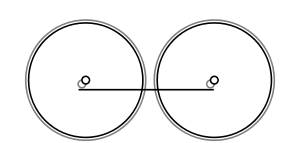0-4-0
 |
|||||||||||||||

Richard Trevithick's Coalbrookedale
|
|||||||||||||||
|
|||||||||||||||
|
|||||||||||||||
|
|||||||||||||||
| Equivalent classifications | |
|---|---|
| UIC class | B |
| French class | 020 |
| Turkish class | 22 |
| Swiss class | 2/2 |
| Russian class | 0-2-0 |
| First known tank engine version | |
|---|---|
| First use | c. 1850 |
| Country | United Kingdom |
| Railway | Caledonian Railway |
| Designer | Robert Sinclair |
| Benefits | Total engine mass as adhesive weight |
| Drawbacks | Instability at speed |
| First known tender engine version | |
|---|---|
| First use | c. 1802 |
| Country | United Kingdom |
| Locomotive | Coalbrookedale |
| Designer | Richard Trevithick |
| Builder | Richard Trevithick |
Under the Whyte notation for the classification of steam locomotives, 0-4-0 represents one of the simplest possible types, that with two axles and four coupled wheels, all of which are driven. The wheels on the earliest four-coupled locomotives were connected by a single gear wheel, but from 1825 the wheels were usually connected with coupling rods to form a single driven set.
The notation 0-4-0T indicates a tank locomotive of this wheel arrangement on which its water and fuel is carried on board the engine itself, rather than in an attached tender.
In Britain, the Whyte notation of wheel arrangement was also often used for the classification of electric and diesel-electric locomotives with side-rod-coupled driving wheels.
Under the UIC classification used in Europe and, in more recent years, in simplified form in the United States, an 0-4-0 is classified as B (German and Italian) if the axles are connected by side rods or gearing and 020 (French), independent of axle motoring. The UIC's Bo classification for electric and diesel-electric locomotives indicates that the axles are independently motored, which would be 0-2-2-0 under the Whyte notation.
The term Four-coupled is often used for 0-4-0 locomotives. Four-wheeled is also sometimes used, but this term can also encompass other wheel arrangements, for example Stephenson's Rocket which was an 0-2-2 four-wheeled locomotive.
0-4-0 locomotives were built as tank locomotives as well as tender locomotives. The former was more common in Europe and the latter in the United States, except in the tightest of situations such as that of a shop switcher, where overall length was a concern. The earliest 0-4-0 locomotives were tender engines and appeared as early as c. 1802. 0-4-0 tank engines were introduced in the early 1850s. The type was found to be so useful in many locations that they continued to be built for more than a century and existed until the end of the steam era.
...
Wikipedia
